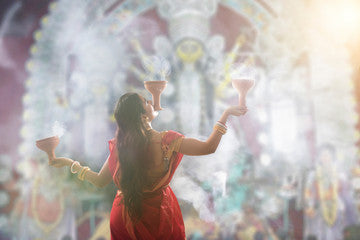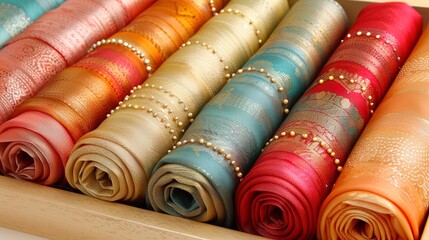The Sustainable Luxury of Matka Silk: A Heritage Weaving Story
In a world that’s embracing conscious consumerism, the allure of matka silk lies not only in its timeless elegance but also in its sustainable essence. This handwoven fabric bridges the gap between heritage and modernity, offering a luxurious, eco-friendly alternative for the discerning buyer. With roots in the rich cultural fabric of India, matka silk has emerged as a preferred choice for those who value craftsmanship, durability, and sustainability.
What Is Matka Silk? A Unique Weaving Marvel
Matka silk is a hand-spun fabric crafted from waste mulberry silk. Unlike smooth silks such as mulberry or tussar, matka silk has a distinctive coarse texture that lends it an earthy and raw appeal. Its slightly irregular weave, often compared to tweed, makes it stand out in a sea of polished, machine-made fabrics.
This uniqueness is the result of using short silk fibers and manual spinning, giving matka silk its characteristic look and feel. Its imperfections are not flaws but a testament to the artistry and skill of traditional Indian weavers.

What Makes Matka Silk Sustainable?
1. Eco-Friendly Production Process
Matka silk is a shining example of upcycling. The production process utilizes waste mulberry silk fibers that would otherwise be discarded, reducing material wastage. By hand-spinning the silk, artisans avoid the use of energy-intensive machinery, minimizing carbon emissions.
2. Biodegradable and Natural
Unlike synthetic fabrics, matka silk is 100% natural and biodegradable. It breaks down naturally over time, leaving no harmful residues behind, making it an ideal choice for environmentally conscious fashion enthusiasts.
3. Supporting Artisanal Livelihoods
The hand-spinning and weaving processes provide employment to rural artisans, particularly in regions like Bengal and Karnataka. Every purchase of a matka silk saree directly contributes to the preservation of traditional crafts and supports sustainable livelihoods.
Matka Silk: A Cultural Legacy
Origins of Matka Silk
Matka silk has its roots in the villages of Bengal, with Murshidabad emerging as a significant hub for its production. Over centuries, this fabric has been an integral part of Indian textiles, cherished for its versatility and durability.
Symbol of Tradition and Elegance
In Bengali households, matka silk sarees are often worn during festivals like Durga Puja and weddings, symbolizing grace and tradition. The sarees, adorned with intricate patterns and Zari borders, reflect the artistic heritage of India.

Why Choose Matka Silk?
Matka silk offers the perfect combination of tradition, sustainability, and luxury. Here’s why it stands out:
1. Unique Texture and Appearance
The coarse texture of matka silk gives it a rustic charm, while its vibrant colors and intricate designs make it suitable for both casual and formal occasions.
2. Durability
Matka silk is sturdier than many other silks, making it an excellent choice for daily wear as well as heirloom pieces.
3. Climate-Friendly Comfort
The breathable nature of matka silk makes it ideal for all seasons. Its ability to adapt to both warm and cool climates adds to its versatility.
4. Versatility in Design
Matka silk can be woven into a variety of styles, including sarees, salwar suits, and even modern Indo-western outfits. Popular designs include soft cotton sarees with Zari borders and matka silk jamdani sarees, blending tradition with contemporary aesthetics.
Matka Silk vs. Raw Silk: What’s the Difference?
Though often confused, matka silk and raw silk are distinct in their origins, textures, durability, and uses. These differences make them unique choices for different occasions and preferences.

Texture and Appearance
Matka silk has a coarse, uneven texture that exudes a rustic, earthy charm. The slubby weave creates a handcrafted appeal, making it ideal for traditional and contemporary ethnic wear. In contrast, raw silk features a smooth but stiff texture with a polished look, often associated with luxury and formal settings.
Durability
When it comes to durability, matka silk surpasses raw silk. Its short fiber weave makes it sturdier and less prone to fraying or damage. This makes matka silk a great option for everyday wear or garments requiring longevity. Raw silk, although beautiful, is less durable and requires more careful handling to prevent wear and tear.
Cost
Matka silk is more affordable because it is made using waste mulberry fibers, which are hand-spun into fabric. This sustainable and cost-effective method keeps the prices lower. On the other hand, raw silk is relatively expensive due to its machine-spun production process and refined finish, catering to high-end fashion and luxury markets.
Production Process
Matka silk is crafted by hand-spinning short mulberry fibers, which is a labor-intensive process often carried out in villages of West Bengal, Bihar, and Assam. This method not only preserves traditional craftsmanship but also ensures eco-friendliness. In contrast, raw silk is machine-spun, resulting in a more uniform and smooth texture but lacking the artisanal touch that matka silk offers.
Versatility and Style
Matka silk is versatile and adapts well to various designs, from sarees and suits to dresses and home décor items like cushion covers. Its breathable nature makes it suitable for both summer and winter. Raw silk, on the other hand, is often used for formal attire such as bridal wear, lehengas, and sherwanis, where a luxurious sheen is preferred.
Sustainability
Matka silk is an environmentally friendly choice, as it reuses waste fibers from the silk-making process. This aligns with the growing demand for sustainable and ethical fashion. Raw silk, while beautiful, does not carry the same sustainable credentials due to its reliance on machine-intensive production and minimal use of waste materials.
Cultural Significance
Matka silk is deeply rooted in Indian heritage and is particularly popular in Bengal. It is often associated with handloom traditions and the artisanal community, making it a symbol of cultural pride. Raw silk, while also significant, is more globally recognized for its luxurious feel and is often used in high-fashion collections.
Maintenance
Matka silk is relatively low-maintenance compared to raw silk. It is less delicate and can handle light washes or dry cleaning without losing its texture. Raw silk, however, requires more care, often needing professional cleaning to maintain its pristine look.
Weight and Comfort
Matka silk is lightweight and comfortable, making it an excellent choice for daily wear and warmer climates. Its breathable nature ensures comfort without compromising on style. Raw silk, being heavier and stiffer, is more suited to colder weather or occasions that call for structured garments.
Color and Dyeing
Matka silk absorbs dyes beautifully, resulting in vibrant colors and intricate patterns that highlight its handcrafted nature. Raw silk, while also taking on dyes well, is generally used in solid, rich tones that emphasize its sheen.
Popularity in Fashion
Matka silk has gained popularity for its blend of tradition and modernity, often showcased in fusion wear. Designers frequently incorporate it into contemporary ethnic outfits. Raw silk remains a staple in haute couture and ceremonial wear, reflecting opulence and grandeur.
By understanding these differences, you can choose the silk that best fits your needs—whether it’s the artisanal charm of matka silk or the refined luxury of raw silk. For authentic matka silk sarees, you can explore collections at Balaram Saha Online, where tradition meets elegance.
Modern Trends: Matka Silk in Contemporary Fashion
With the rise of sustainable fashion, matka silk is making a strong comeback. Designers are experimenting with its unique texture, creating everything from sarees to jackets and skirts. Popular styles include:
- Handloom Cotton Saree with Zari Border: Perfect for traditional events with a touch of elegance.
- Pure Matka Silk Sarees: Ideal for weddings and festive celebrations.
- Bengali Silk Saree: A timeless favorite that blends cultural heritage with modern trends.
Caring for Your Matka Silk Saree
To ensure your matka silk saree remains as beautiful as the day you bought it, follow these care tips:
- Dry Cleaning is Key: Avoid washing at home to maintain the fabric’s sheen.
- Store with Care: Keep your saree in a muslin cloth to protect it from moisture and insects.
- Iron Gently: Use a low heat setting to iron your saree and avoid direct heat.
Where to Find Authentic Matka Silk Sarees
Finding genuine matka silk sarees requires a careful selection of trusted sellers. Balaram Saha Online offers a wide range of handloom sarees, including:
- Pure Matka Silk Sarees
- Soft Cotton Sarees with Zari Borders
- Bengali Silk Sarees
Each piece at Balaram Saha Handloom Saree Store reflects the artistry and dedication of Indian weavers, ensuring authenticity and quality.
Matka Silk: A Fabric for Every Occasion
Whether it’s a grand wedding, a festive celebration, or a formal event, matka silk sarees offer unmatched versatility. Their vibrant hues, intricate designs, and sustainable nature make them a must-have in every wardrobe.






